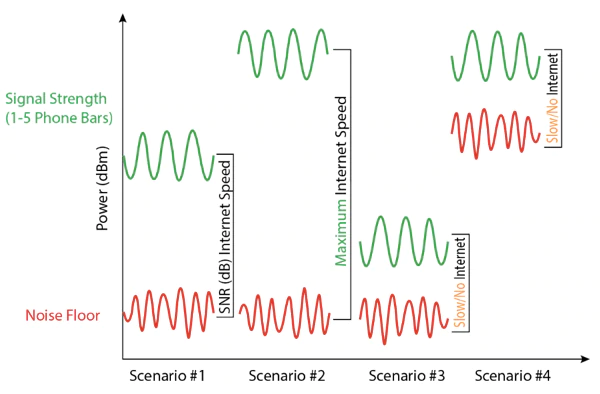The LTE signal strength of the LTE network is related to the network speed, but it is not absolutely related. The signal strength displayed on our mobile phone mainly refers to RSRP. The LTE network signal strength displayed on our mobile phone is also the one seen on the mobile phone. The signal of a few grids reflects the range of the RSRP value. However, the download speed of the mobile phone is closely related to the quality of the downlink channel, and the direct reflection of the quality of the downlink channel is the SINR value.
1. LTE Signal Strength Values
Below are explanations of the LTE signal strength values (and also RSSI in relation to LTE):
1.1 SINR/SNR – The signal-to-noise ratio of the given signal.
1.2 RSRP – The average power received from a single Reference signal, and Its typical range is around -44dbm (good) to -140dbm(bad).
1.3 RSRQ – Indicates quality of the received signal, and its range is typically -19.5dB(bad) to -3dB (good).
1.4 RSSI – Represents the entire received power including the wanted power from the serving cell as well as all co-channel power and other sources of noise and it is related to the above parameters through the following formula:
1.4.1 RSRQ=N*(RSRP/RSSI) - Where N is the number of Resource Blocks of the E-UTRA carrier RSSI measurement bandwidth.
2. LTE Signal Strength vs Signal Quality
2.1 "LTE Signal strength" is how strong the signal you're receiving is, and it is measured in dBm. The closer your cell device is to the cellular tower transmitter, the more signal your cell phone or Mi-Fi antenna will pick up. The farther away from the tower your cellphone or MiFi is, the more your signal level will drop and you may need a signal booster kit to compensate.
2.2 On other hand, "signal quality" is measured by how noisy a band is. In essence, "signal quality" is like how much water there is (voice and data transmission capability), versus how many waves are in the water (noise that disrupts, distorts, or alters the core transmission). Quality is how much interference there is between the cell tower and your cellular device. It is how good the signal is that you receive or how good it will keep during rainy, snowy, or stormy conditions. All signals hold reflections, ghosting, or interference that we call "noise". Noise is what causes cell phone voice calls to not sound realistic as they do in real life. The noise is considered to be low if the quality is high or good.




















